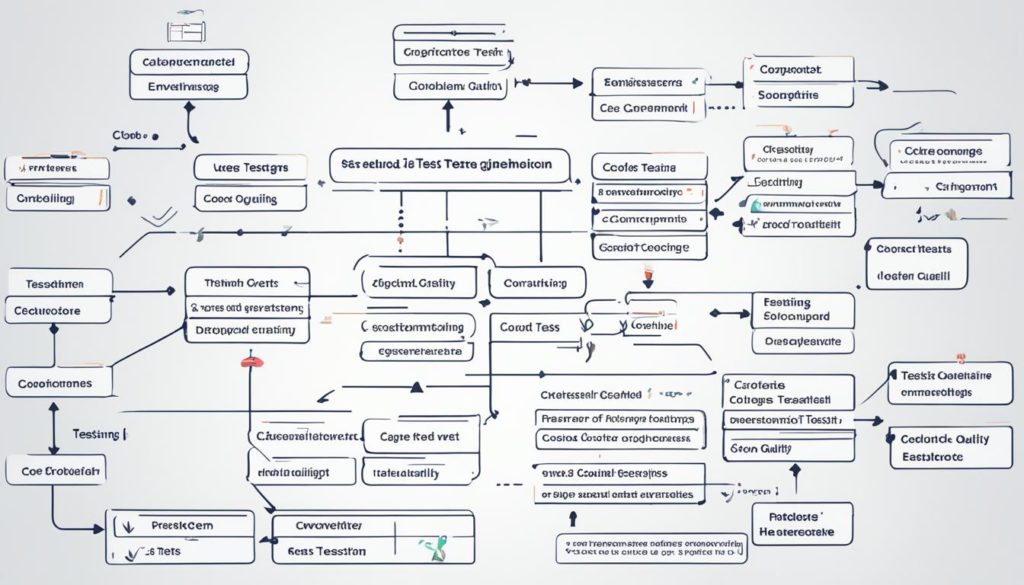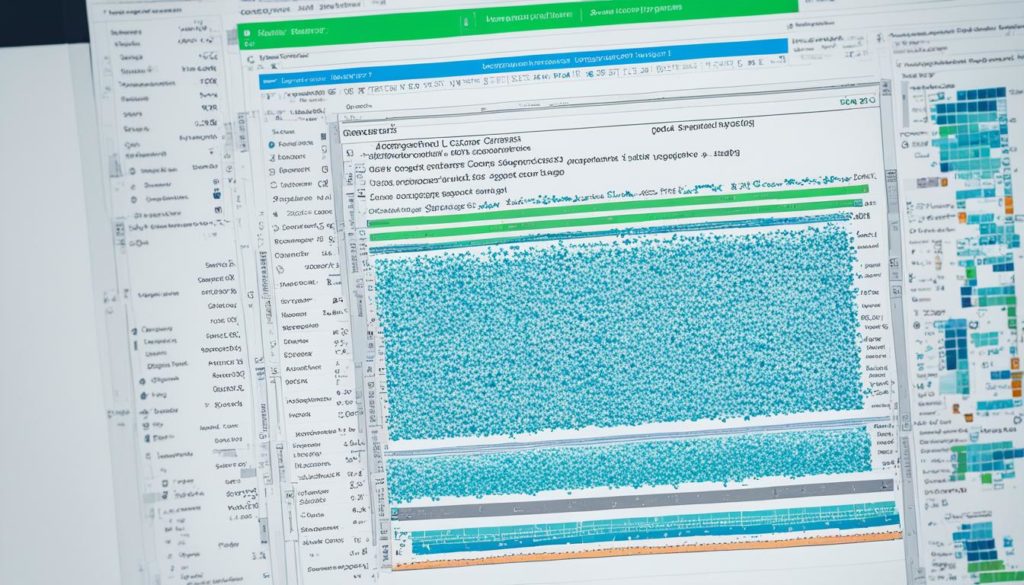
In the past few years, the question of how to test image sources in React Native components has drawn a lot of attention, with over 70,000 views. This shows a strong need for consistent testing. As we look into React unit testing, we find a lack of standard methods complicates things. Despite efforts over four years, a clear choice in Jest testing remains out of reach.
The quest for top-notch software grows. This makes tools like Jest and front-end testing more crucial. They support test-driven development and JavaScript testing as essential steps in the development process.
When we focus on Testing React components, we encounter an ever-changing scene. From different implementation methods like getByDataTestId to various assertion techniques on image URIs, the challenges are clear. The React unit testing realm is vast and challenging to navigate.
Sharing code, examples, and best practices among developers highlights the power of the Test-driven development approach. By relying on the Jest testing framework, we ensure our code’s quality is exceptional.
Our goal is straightforward: With input from the community and advanced techniques, we aim to improve the unit testing process with Unit Test React Jest. We strive for flawless code that meets both time’s challenges and user expectations.
By using Jest and Enzyme, we enhance our front-end testing, contributing to fewer errors. This reflects the React community’s commitment and expertise.
Key Takeaways
- There is a pronounced demand for knowledge on testing image sources in React Native, signified by the tens of thousands of developers who have sought guidance.
- The variability in testing methods within the React community underscores the need for a tailored, consistent approach to unit testing.
- Jest, coupled with React Native’s testing library, has become a cornerstone for JavaScript testing, despite the absence of usage uniformity.
- Test-driven development emerges as a transformative practice that continuously informs the React unit testing landscape.
- Understanding and implementing Jest and Enzyme is pivotal for advancing code quality in React projects.
- Through shared knowledge and evolving techniques, React developers are collectively enhancing the robustness and reliability of front-end applications.
- Ultimately, the drive for high-quality code is the unifying mission that propels the React testing community forward.
The Significance of Unit Testing in Front-End Development
As web technologies advance, front-end applications get more complex. This makes React unit testing a key part of development. It ensures that components work as they should. This helps maintain the quality and reliability of applications.
Ensuring Reliable Code with Unit Test React Jest
Using the Jest test suite in React applications helps check each component. This leads to code that is free from errors. Jest can find issues early, preventing them from reaching the user. Find out more by looking at this essential guide on unit testing of React apps using Jest.
The Impact of Jest on Development Workflow
Jest makes development faster by automating test tasks. It gives quick feedback and works well with React. Developers enjoy using it to speed up testing without losing quality.
Driving Code Quality Through Test-Driven Development
TDD with Jest and React unit testing encourages writing tests before code. This leads to better code and designs. It makes software more maintainable and of higher quality.
Efficient testing is key for top performance and access. The data below points out major areas:intake for pregnant women is important for the baby and the mom. Here’s how certain protein sources compare:
| Testing Aspect | Strategy | Impact |
|---|---|---|
| Code Coverage in Jest | Add –coverage flag | Ensures thoroughness |
| Performance Optimization | Parallel testing, limit snapshots | Enhances speed |
| Accessibility with Jest Axe | Integration of Axe core | Improves usability for all |
Jest and React together form a strong base for quality web apps. As we use more of these tools in React unit testing, our goal to make perfect software stays strong.
Configuring Your Environment for Jest and Enzyme
Starting with Jest and Enzyme for React projects is key to using unit test best practices. The core of this setup is choosing the right packages for thorough testing. A top pick is Create React App because of its user-friendly Jest support, making the start easier.
If you didn’t start with Create React App, you’ll need to mix in different npm packages. These include jest, babel-jest, @babel/preset-env, and @babel/preset-react. This mix helps mimic the production setting for accurate tests. Adding react-test-renderer is essential for snapshot testing, ensuring your UI doesn’t change unexpectedly.
For Enzyme, add a ‘setupTests.js’ file to your ‘src/’ directory. This step makes Enzyme work with your React version, keeping things working smoothly. Include some scripts in ‘package.json’ for easy testing and to get detailed reports.
Fixing common issues ensures Jest and Enzyme work well in your projects. With React 16+ and Enzyme, snapshot testing might show warnings. You can solve this by changing how tests are run or using react-test-renderer’s custom elements.
Boost your testing game by using libraries like @testing-library/react for more test options. Or get into custom transformers with babel-jest and @babel/core for complicated tests. These advanced steps help create a solid, quality-focused development process for your React apps.
Mastering React Unit Testing with Jest and Enzyme
For React applications to work perfectly, knowing how to use Jest testing and Enzyme setup is key. These tools check new features and protect existing ones.
Creating Robust React Components with Enzyme
Enzyme is great for simulating React components. It uses shallow rendering to test a component by itself. This method is key for unit tests, keeping components independent.
Mocking and Snapshot Testing: The Jest Advantage
Jest’s snapshot testing captures a component’s look and feel. It helps spot unintended changes, ensuring the UI stays consistent. Jest also offers easy ways to test complex scenarios without complex setups.
Jest Testing Techniques and Debugging Tips
It’s smart to use Jest for debugging because of its clear syntax and detailed error reports. This makes it easier to find and fix issues. Following Javascript testing best practices, like testing components separately, improves test quality.
Adapting to React’s changes is crucial for effective testing. Below, a table shows how Jest and Enzyme handle common testing scenarios. It’s a good guide for improving your React testing setup.
| Feature | Jest | Enzyme | |||
|---|---|---|---|---|---|
| Rendering Type | Full DOM | Shallow Rendering | |||
| User Simulations | Yes, with mock functions | Yes, using simulate() | |||
| Snapshot Testing | Supported | Limited support | |||
| Component Isolation | Not a primary focus | Excellent for isolated testing | State Manipulation | Limited | Direct state access and manipulation |
Exploring Jest and Enzyme shows their importance in web development. By mastering them, we ensure our React apps are strong, fast, and easy to maintain.
Utilizing Advanced Jest Features for Enhanced Testing
We’re exploring React testing’s depths with advanced Jest functions and enhanced Jest testing strategies. These improve our test’s quality and speed. The rise of Jest custom functionalities has been revolutionary. It lets us recreate complex, real-world scenarios for precise testing.
When we talk about unit test best practices, testing custom React hooks is a standout. Jest’s power is evident in these tests. Imagine a React hook calling an API and managing its loading state. We use a dummy component for the hook. This way, we can check if the outcomes match our expectations. Here’s how we do it:
- Mocking Fetch Calls: We replace real network requests with fake ones. This gives us control over API testing, avoiding real data use.
- Testing Asynchronous Behavior: Jest helps us with asynchronous tasks by handling promises and their outcomes. It’s key for hooks that rely on outside data.
- Component Rendering and State Validation: We do a render test to see how the component acts when its state changes due to API calls. We make sure loading indicators and data displays work right.
This systematic strategy makes our workflow smoother. It boosts our trust in the app’s performance and reliability.
| Test Phase | Approach | Outcome |
|---|---|---|
| Initial Setup | Mock components and API | Environment ready for isolated testing |
| Behavior Testing | Simulate API responses and user interactions | Behavior under various conditions verified |
| State Validation | Check component states post-API interaction | Correct state management confirmed |
By using advanced techniques, we change how we build, test, and launch React apps. We make sure they work perfectly and meet everyone’s expectations.
Conclusion
In frontend development, especially in React, unit testing is super important. Tools like Jest and Enzyme have changed how we make sure our code is good. By using Test-driven development, we find problems early and make our work better.
Unit testing with React and Jest, combined with other tests like Cypress, gives us a full kit for testing. This makes our React apps strong and stable. Having a strict testing plan helps ensure our software is high quality.
By adopting these careful testing practices, our React apps do more than work well; they are also enjoyable to use. These efforts build trust in our apps among both developers and users. With the latest testing tools and strategies, our apps become examples of excellence in software.
FAQ
What is Unit Test React Jest?
Unit Test React Jest is about testing React components individually. It uses the Jest testing framework. Jest is great for testing JavaScript. It ensures our code is reliable and supports test-driven development in React apps.
How does unit testing enhance front-end development?
Unit testing is key for checking each component’s function in front-end development. It makes our code trustworthy and catches mistakes early. It also leads our coding efforts and keeps our standards high.
What impact does Jest have on the development workflow?
Jest improves our development flow with features like mock functions and watch mode. These features help us debug better. This leads to quicker and more dependable development cycles.
Why is configuring your environment for Jest and Enzyme important?
Setting up Jest and Enzyme right is crucial for smooth, efficient test runs. It lays the groundwork for good unit testing and lets us accurately mimic React’s environment. This keeps the quality of our React components up.
What does mastering React unit testing with Jest and Enzyme entail?
Being a pro at React unit testing means using Jest and Enzyme’s full potential. We should know shallow rendering, how to mock dependencies, and use snapshot tests well. These skills help us improve and fine-tune our React apps.
How can we utilize advanced Jest features to enhance our testing?
To better our tests, we can use Jest’s advanced features like custom matchers and testing hooks. Mocking modules and timers lets us build detailed test suites for React apps.
What are the benefits of test-driven development in React?
Test-driven development (TDD) boosts code quality and finds bugs early. It makes coding more organized. Writing tests before code ensures React components work as expected, making our codebase reliable and easier to maintain.
How does Jest facilitate JavaScript testing for React components?
Jest offers a specialized testing platform for React components. It’s good for testing asynchronously, mocking, and snapshot testing. Jest keeps track of UI changes and renders components for tests, which helps React developers.
What are some Jest testing best practices?
Best practices in Jest testing include writing clear tests and using Jest’s matchers for checking results. We isolate components by mocking outside dependencies, organize tests well, and test all key scenarios. It’s important to keep tests up-to-date as our code evolves.
What is the importance of frontend testing frameworks in modern web development?
Frontend testing frameworks are essential today. They check web apps’ functionality, usability, and stability. These frameworks automate testing, saving time and increasing test accuracy. This is vital for continuous integration and deployment.
Future App Studios is an award-winning software development & outsourcing company. Our team of experts is ready to craft the solution your company needs.










